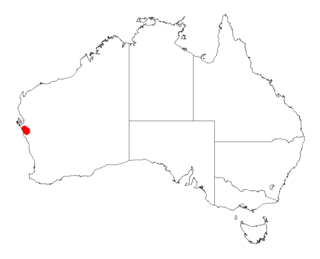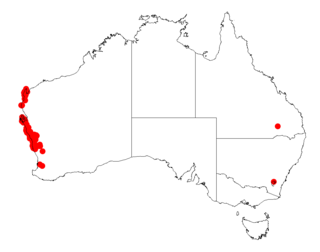
Acacia merrallii, commonly known as Merrall's wattle, is a shrub belonging to the genus Acacia and the subgenus Phyllodineae that is endemic to south western and southern Australia.

Acacia merrickiae is a shrub belonging to the genus Acacia and the subgenus Phyllodineae that is endemic to a small area of south western Australia.

Acacia pachyphylla is a shrub belonging to the genus Acacia and the subgenus Phyllodineae that is endemic to south western Australia.

Acacia plautella is a shrub belonging to the genus Acacia and the subgenus Phyllodineae that is endemic to a small area along the coast of western Australia.

Acacia puncticulata is a shrub of the genus Acacia and the subgenus Phyllodineae that is endemic to an area along the west coast of Australia.

Acacia pusilla is a shrub of the genus Acacia and the subgenus Phyllodineae the is endemic to south western Australia.
Acacia pygmaea, commonly known as the dwarf rock wattle, is a shrub of the genus Acacia and the subgenus Phyllodineae that is endemic to south western Australia.

Acacia quinquenervia is a shrub of the genus Acacia and the subgenus Phyllodineae that is endemic to south western Australia
Acacia rhamphophylla, commonly known as Kundip wattle, is a shrub of the genus Acacia and the subgenus Phyllodineae that is endemic to a small area in south western Australia. It is listed as an endangered species according to the Environment Protection and Biodiversity Conservation Act 1999.

Acacia scleroclada is a shrub of the genus Acacia and the subgenus Phyllodineae that is endemic to an area of western Australia.

Acacia spathulifolia commonly known as Gold carpet or the Gold carpet wattle is a shrub of the genus Acacia and the subgenus Phyllodineae that is endemic to coastal parts of western Australia.

Acacia sphenophylla is a shrub of the genus Acacia and the subgenus Phyllodineae that is endemic to a small area in western Australia.

Acacia validinervia also commonly known as nyalanyalara, nyala nyala, alumaru or blue wattle, is a shrub of the genus Acacia and the subgenus Phyllodineae endemic to arid areas of inland Australia.

Acacia juncifolia, commonly known as rush-leaf wattle, is a shrub or tree belonging to the genus Acacia and the subgenus Phyllodineae that is endemic to north eastern Australia.

Acacia pedina is a tree or shrub belonging to the genus Acacia and the subgenus Phyllodineae native to eastern Australia.

Acacia quornensis, commonly known as Quorn wattle, is a shrub belonging to the genus Acacia and the subgenus Phyllodineae native to southern Australia.

Acacia rivalis, commonly known as silver wattle or creek wattle, is a shrub or tree belonging to the genus Acacia and the subgenus Phyllodineae native to southern Australia.

Acacia simmonsiana, commonly known as Simmons wattle or desert manna wattle, is a shrub belonging to the genus Acacia and the subgenus Phyllodineae native to south eastern Australia.
Acacia toondulya is a tree belonging to the genus Acacia and the subgenus Phyllodineae native to southern Australia.

Acacia linearifolia, commonly known as stringybark wattle or narrow-leaved wattle, is a shrub or tree of the genus Acacia and the subgenus Phyllodineae that is endemic to eastern Australia.

















